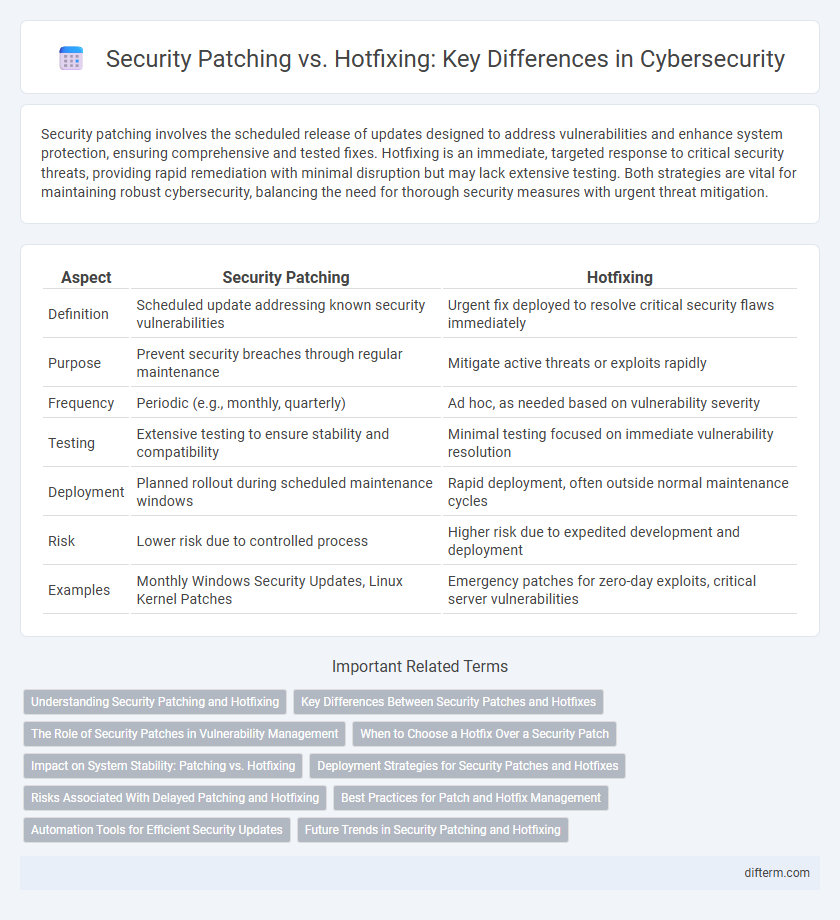Security patching involves the scheduled release of updates designed to address vulnerabilities and enhance system protection, ensuring comprehensive and tested fixes. Hotfixing is an immediate, targeted response to critical security threats, providing rapid remediation with minimal disruption but may lack extensive testing. Both strategies are vital for maintaining robust cybersecurity, balancing the need for thorough security measures with urgent threat mitigation.
Table of Comparison
| Aspect | Security Patching | Hotfixing |
|---|---|---|
| Definition | Scheduled update addressing known security vulnerabilities | Urgent fix deployed to resolve critical security flaws immediately |
| Purpose | Prevent security breaches through regular maintenance | Mitigate active threats or exploits rapidly |
| Frequency | Periodic (e.g., monthly, quarterly) | Ad hoc, as needed based on vulnerability severity |
| Testing | Extensive testing to ensure stability and compatibility | Minimal testing focused on immediate vulnerability resolution |
| Deployment | Planned rollout during scheduled maintenance windows | Rapid deployment, often outside normal maintenance cycles |
| Risk | Lower risk due to controlled process | Higher risk due to expedited development and deployment |
| Examples | Monthly Windows Security Updates, Linux Kernel Patches | Emergency patches for zero-day exploits, critical server vulnerabilities |
Understanding Security Patching and Hotfixing
Security patching involves deploying comprehensive updates to software systems that address multiple vulnerabilities and improve overall stability, ensuring long-term protection against cyber threats. Hotfixing targets specific, critical security issues with immediate, targeted corrections, minimizing exposure while awaiting broader patch releases. Understanding the distinction between patching and hotfixing enables organizations to implement timely and effective responses to security vulnerabilities, optimizing risk management strategies.
Key Differences Between Security Patches and Hotfixes
Security patches are comprehensive updates designed to address multiple vulnerabilities and improve overall system security, typically released on a scheduled basis. Hotfixes target specific critical issues or vulnerabilities, providing an immediate corrective measure without requiring a full system update. The key differences lie in their scope, urgency, and deployment frequency, with patches offering broader, planned improvements and hotfixes delivering fast, targeted solutions.
The Role of Security Patches in Vulnerability Management
Security patches play a critical role in vulnerability management by addressing known security flaws and preventing exploitation by threat actors. Timely deployment of security patches reduces the attack surface, ensuring systems remain protected against emerging vulnerabilities. Unlike hotfixes, which are quick temporary solutions, security patches provide comprehensive, thoroughly tested updates that maintain long-term system integrity and compliance.
When to Choose a Hotfix Over a Security Patch
Choose a hotfix over a security patch when an immediate vulnerability requires urgent mitigation to prevent active exploitation or minimize business disruption. Hotfixes provide rapid, targeted solutions without the extensive testing or full update cycles associated with standard security patches. Opt for hotfixes in critical scenarios where timing outweighs the risks of potential stability issues inherent in quick fixes.
Impact on System Stability: Patching vs. Hotfixing
Security patching involves thorough testing and scheduled deployment, minimizing risks and ensuring overall system stability, whereas hotfixing applies immediate, targeted fixes often without extensive validation, increasing the potential for system conflicts or instability. Patches typically undergo regression testing to confirm compatibility with existing software, reducing the chance of introducing new vulnerabilities or bugs. Hotfixes, while critical for urgent threat mitigation, may lead to unforeseen system crashes or performance issues due to limited testing time.
Deployment Strategies for Security Patches and Hotfixes
Effective deployment strategies for security patches and hotfixes emphasize minimal downtime and rapid vulnerability mitigation. Security patches are typically rolled out through scheduled updates using automated patch management systems to ensure thorough testing and compliance. Hotfixes demand expedited deployment often via targeted, manual installations or immediate rollbacks to quickly address critical security flaws without disrupting production environments.
Risks Associated With Delayed Patching and Hotfixing
Delaying security patching and hotfixing exposes systems to vulnerabilities that attackers can exploit, increasing the risk of data breaches and unauthorized access. Unpatched software often becomes a target for malware, ransomware, and other cyber threats, compromising the integrity and confidentiality of critical information. Timely implementation of patches and hotfixes is crucial to mitigate these risks and maintain robust cybersecurity defenses.
Best Practices for Patch and Hotfix Management
Effective security patching and hotfixing require a structured process that includes thorough testing, timely deployment, and detailed documentation to minimize vulnerabilities and system disruptions. Prioritize critical patches and hotfixes based on severity and impact assessments, ensuring all patches are validated in a controlled environment before production release. Implement automated patch management tools combined with continuous monitoring to maintain up-to-date defenses and streamline compliance with security policies.
Automation Tools for Efficient Security Updates
Automation tools like Ansible, Puppet, and Chef streamline security patching by enabling consistent, large-scale deployment across diverse environments. Hotfix automation leverages real-time monitoring and orchestration platforms such as Rundeck and SaltStack to quickly address critical vulnerabilities without disrupting system stability. Integrating these automation solutions enhances the efficiency and accuracy of security updates, minimizing downtime and reducing the risk of exploitation.
Future Trends in Security Patching and Hotfixing
Future trends in security patching and hotfixing emphasize automation and artificial intelligence to accelerate vulnerability detection and remediation. Cloud-native environments drive continuous deployment practices, enabling real-time patch distribution without downtime. Enhanced integration of machine learning models predicts exploit patterns, optimizing hotfix prioritization for reduced security risks.
Security patching vs hotfixing Infographic

 difterm.com
difterm.com